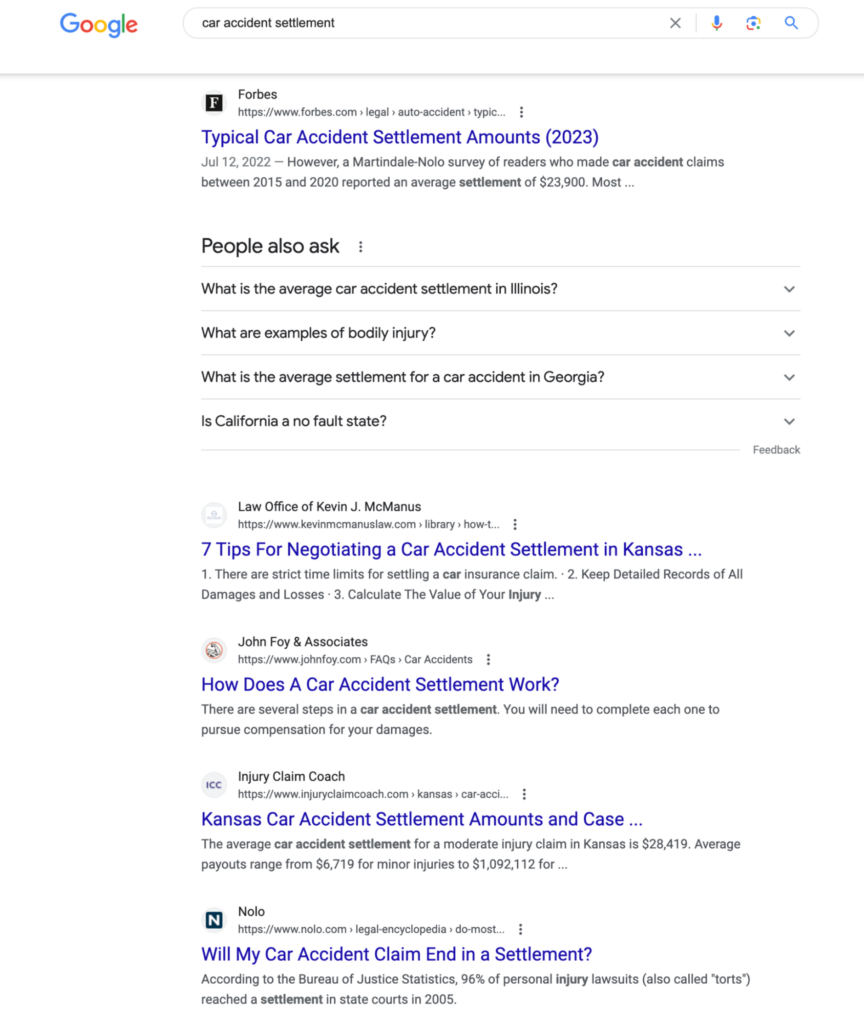Making content that meets your target audience’s needs is one of the most important parts of an SEO-driven marketing campaign.
Content that ignores what people want won’t rank as well as content that respects search intent. Figuring out what people want can be difficult, but a few tricks can make it simple.
What is Search Intent?
People want answers when they search on Google. And Google wants to make sure people get those answers quickly—without having to refine their search over and over (that’s why so many people use Google and not Bing…or Yahoo).
You have to understand what people want—and give it to them—if you want to rank well.
The best way to do that is by seeing what Google thinks is worth ranking. If you see Google ranking a bunch of pages explaining how to hire a lawyer, you’ll know people aren’t looking for a landing page with an attorney pitching their services.
Spotting the search intent for a keyword isn’t hard once you know what to look for. First, you’ll need to assess the reasons why someone searches for a topic. Then you need to figure out what they want to find when they search.
The Four Broad Types of Search Queries
People’s reasons for typing in a keyword fall into one of four different buckets. These are broad categories, but they help uncover the searcher’s basic motivation.
Informational
Informational searches are one of the most common types of search intent. People with an informational intent want to learn or find information about a topic.
Some examples of informational queries are:
- “how to become a lawyer”
- “how to file an accident claim with my insurance”
- “nausea after car accident”
- “car accident settlement calculator”
- “average settlement for car accident”
- “can i sue for pain and suffering”
- “car accident injuries”
Investigational
Investigational queries are ones where someone is looking to do something with the information they’ve learned. Investigational searches are active for learning, while informational searches are passive.
Some examples of investigational searches include:
- “hiring a lawyer vs doing it yourself”
- “morgan and morgan reviews”
- “top attorney in boston”
- “best car accident lawyers”
- “personal injury attorney”
Transactional
Transactional searches occur when someone is looking to buy a product or service.
Some examples of searches using transactional keywords are:
- “buy new iphone”
- “hire morgan and morgan”
- “microsoft office business price”
- “brioni polo”
- “clio pricing”
Navigational
Navigational search intents are the least complicated. People have a navigational keyword intent when they use Google to find another website.
Navigational queries can look like:
- “linkedIn”
- “westlaw”
- “california state bar association”
- “google”
Determining a keyword’s intent type helps you understand the underlying reason for the search. But it’s only the first part of figuring out what the searcher wants.
How to Check Search Intent with Google
Finding the intent type shows you why someone searches for a topic. Now you need to determine what kind of content they want to find to solve their need.
You can figure out what people want by just looking at Google’s search results.
There are three factors to pay attention to when looking at a keyword’s search results. Identifying the ranking page’s content type, content format, and content angle will show you what Google thinks the searcher wants.
The first factor to look at is content type. This refers to the overall type of page that Google wants to rank for a topic. For example, some searches are better suited to blog posts. At other times, people would rather see a landing page for a service.
Content types can be any one of the following:
- Article
- Video
- Product
- Product Category Page
- Service/Feature Page
- Other
Here’s how you can check a Google results page to determine the content type.
When you review the ranking pages for intent, it’s usually best to look at the first three or four results. These are the pages that Google’s algorithm thinks are doing the best job of hitting the intent. Pages and posts tend to be less true to the intent as you scroll down the search results.
The next search intent factor to look for is content format. You can think of formats as subtypes. For example, a guide and a list are different subtypes of articles.
Content types can be any of the following.
- Guide
- List
- Roundup
- Opinion
- Tool
- Report
- eBook
- Commercial
- Other
Note that not all formats will go with all content types. For example, you won’t see any service pages with the format of a guide.
Check out the walkthrough below to see how content formats build on types. For these examples, we’ll use results where the intent is for an article.
The last search intent factor to analyze is the content angle. You can think of this as the direction to take with your content.
Here are some examples of content angles:
- Definitional
- How to
- Top X
- Best X
- Year/Freshness
- Pros and Cons
- Benefits
- Versus
Here’s how you can identify the angle that you should take by looking at Google search results:
You can look at almost any search results page through the lens of these factors. When you do, it’s easy to tell what kind of content you should create.
How to Check Search Intent with Ahrefs
Looking at Google isn’t the only way to check a keyword’s search intent.
If you already use Ahrefs for rank tracking and keyword research, you can also use it to assess search intent. The walkthrough below will guide you through the process of using Ahrefs Keywords Explorer to determine what type of content to create when you want to rank for a keyword with a new piece of content.
Using Ahrefs to determine intent may not be the best decision in all cases. If your business handles a lot of local clients, for example, you should stick to checking Google. Some of the terms you want to target may be localized, and Ahrefs may not be able to pick that up.
What If Intent Isn’t Clear?
A mixed intent happens when it’s not clear exactly what the searcher is looking for.
This can happen for a few different reasons. Sometimes the search term is so broad that searchers could be looking for any number of things. Other times, people’s shifting wants and needs mean the results are in flux.
A good example of a mixed intent results page is the keyword car accident settlement.

The content type and format are clear in these results. People are looking for an article, and that article should be a guide. But the angle isn’t clear at all.
Mixed intent results make it harder to decide what angle you should take to rank. In some cases, you might need to take your best shot, see how it pans out, and decide if an alternate angle is a better approach.
Doing that comes with some obvious opportunity costs.
Applying a strategic thinking framework we adapted from Roger L. Martin’s book Playing to Win can help you decide if chasing that target keyword is worth it. Ask yourself:
- Is this keyword worth competing over?
- Is this a keyword that I have a chance of ranking for?
- How could I create a piece of content that addresses the searchers’ needs, or is there a need that isn’t being met?
The keyword car accident settlement is probably still worth going after if you’re a personal injury lawyer.
The term has a high search volume and traffic potential, so it’s worth competing over. All of the ranking pages are law firms or related to the law, so another law firm stands a competitive chance. All that remains is to ask yourself what you can do to create high-quality content that stands out from the field.
Final Thoughts
Understanding search intent puts you in a position to create better SEO content.
When you understand what it is that people are looking for, you’ll have an easier time creating relevant content that satisfies their needs. You’ll also be able to look at your existing content to find opportunities to optimize it for intent after performing an SEO audit.
But determining search intent is just one part of driving organic traffic to your website.
Pairing your newfound knowledge with other skills is a necessity. Knowing the intent won’t help much with doing keyword research first. And you have to be able to bring great writing to the table to outrank entrenched competitors.
If that sounds like an uphill battle to do on your own, consider reaching out to a search engine optimization expert. At Rankings.io, we help lawyers get the most out of their websites. Contact us today to see how we can help you dominate Google’s search engine results pages.
The post How to Identify Search Intent: An Interactive Guide appeared first on Rankings.




